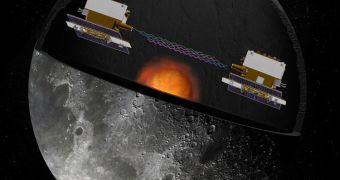As the hours count down to T-0, scientists and mission controllers involved with the NASA Gravity Recovery And Interior Laboratory (GRAIL) twin spacecraft project are trembling with anticipation. This mission will reveal a wealth of knowledge about Earth, the Moon and the solar system.
There are only two, 1-second launch windows available for today's planned launch attempt, at 8:37 am and 9:16 am EDT (1237 and 1337 GMT), respectively. The overall launch window runs until October 19, so NASA has plenty of time for maneuvers.
GRAIL will take off from the Cape Canaveral Air Force Station's (CCAFS) Space Launch Complex 17B (SLC-17B), aboard a Delta II 7920H-10 delivery system. The spacecraft are scheduled to begin their science mission in March 2012, but the date depends on the success of the testing phase.
Both probes will take about three-and-a-half months to reach their destination, as they will be traveling through the Sun-Earth Lagrange Point 1 rather than a direct lunar-injection orbit. This option was selected because of the massive fuel savings it makes possible.
As soon as its primary mission starts, scientists will be able to answer fundamental questions about the Moon’s composition, internal structure and evolution. Our planet's evolution, and the early history of the solar system implicitly, will also become clearer.
GRAIL also achieves a few firsts in space exploration. It has the most sensitive gravity-measuring instruments, it is the first NASA mission to be led by a professor at the Massachusetts Institute of Technology, and the first planetary spacecraft mission led by a woman.
Maria Zuber, the Earle A. Griswold Professor of Geophysics and Planetary Science at MIT, is the principal investigator for the mission. GRAIL will be managed by experts at the NASA Jet Propulsion Laboratory (JPL), in Pasadena, California.
“Technologically, it is blazing the trail for other planetary missions,” explains Zuber, who also holds an appointment as the head of the MIT Department of Earth, Atmospheric and Planetary Sciences.
“Using dual spacecraft in tight-formation flight, doing precise timing and gravity measurement, you could envision future planetary missions to Europa to map currents in its subsurface ocean; to Venus to map the circulation of its atmosphere; and to Mars to observe the seasonal carbon dioxide cycle between its atmosphere and its surface,” she adds.
One of the most interesting aspects of the new mission is that its results will be combined with the detailed topographical models of the Moon's surface that were produced by the NASA Lunar Reconnaissance Orbiter (LRO).
Zuber is the deputy principal investigator for the LRO mission. She says that the high-resolution laser altimeter on the orbiter will provide interesting correlations to GRAIL's data on the distribution of matter inside Earth's natural satellite.
“We have over four billion measurements of elevation on the Moon from the LRO altimeter, so we will be correlating these two data sets. What we stand to learn in terms of crustal structure of the moon is really going to be unprecedented in planetary science,” she adds.
The duo will fly above the lunar surface in formation, in varying orbits. As they move over each area, differences in material distribution inside the Moon will exert a heavier or lighter gravitational pull on one of the probes.
As this happens, the distance between the two will be slightly modified, but more than enough for the mission's ultra-sensitive science suite to pick up and analyze. In this manner, NASA wants to cover the entire surface of the satellite, producing the most detailed and precise gravity map to date.
The average distance between GRAIL-A and GRAIL-B will vary depending on the orbits they occupy, within 75 to 225 miles (121 to 362 kilometers).

 14 DAY TRIAL //
14 DAY TRIAL //